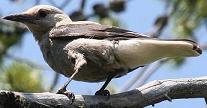Clark's
Nutcracker
Named after William Clark who observed the
bird during the Lewis and Clark expedition in 1805.
Identification and Pictures
(Nucifraga columbiana)  A
member of the crow family Clark's nutcracker has the build of
a small crow and is about 12 to
13 inches. It has a light gray body, white patches in
black wings, and tail. Its long sharp bill is
perfect for extracting nuts from pine cones. Juveniles
are similar to adult, but are buff gray with dull black or brown wings.
They have a pouch under their tongue that they use to carry
pine seeds long distances where they cache them for later use.
Caches are generally buried in the soil on exposed slopes.
They will hide thousands of seeds, and studies show the bird
will remember where it hides most of them as much as 9 months
later.
Photos
by Keith Lee. The camera I use is the Canon
EOS 40D. Visit All-birds store
Clark's nutcracker is sometimes mistaken for
Gray Jays but the lay does not have the white wing patches and
has a much smaller bill.
Sound of Clark's NutcrackerThey make many different sounds,
but the most common call is a grating khaa-khaa-khaa. sound
Preferred Habitat
Nutcrackers are found in much of the American
west, flying in loose groups outside of nesting season. They like to be near the tree line of coniferous forest
in the mountains, often seen in mountain resorts.
Breeding and Nesting
Pairs of nutcrackers form long term bonds, and
will stay in their territory year long. In late winter
they begin nesting.
The nest which is a deep bowl of twigs, and
bark lined with pine needles, grass, and leaves in coniferous
trees is built by both birds.
Females lay 2 to 6 green spotted eggs. The
male will help incubate the eggs for around 18 days, and even
develops a brood pouch like the female. Both parents
help feed the young which will leave the nest in around 20
days. The young birds will be fed from seeds the parents
stashed away earlier. The young will stay with the
parents for 3 to 4 months. Storing seeds for the young
allows nutcrackers to stay in high elevations year round, and
to breed as early as January or February.
Clark's nutcrackers have a symbiotic relationship with pine
trees. The trees provide food for the birds and in
return cashes the birds do not eat produce pine trees.
Food
They feed on nuts, insects, berries, eggs, small mammals, and carrion.
They will eat suet, and sunflower seeds. These birds are very bold around humans, and often
come to picnic and camping areas to beg for handouts.
For more on food
and feeding click here.
For more on feeders click here.
To learn about other favorite
birds click here

|
